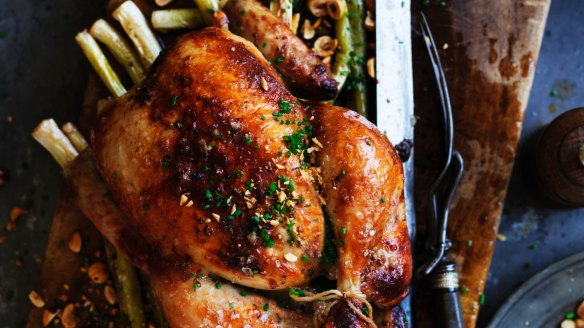How to make crisp chicken skin and other tips for a better roast chook

Should I truss my roast chicken? V. Bainbridge
Trussing involves tying the ends of the legs together with cotton kitchen twine in a figure-eight fashion. This holds the birds in shape and the legs and thighs against the frame. In days gone by, when chooks had smaller breasts and less developed thighs, trussing ensured the birds cooked evenly. Modern chooks don't need trussing. These days, trussing a chook could see the breast cooked through, but the plump thighs still pink. Smaller birds, such as poussin, and game birds should be trussed, however.
Also – don't worry about basting your bird. Basting means pouring very hot oil over the skin. This process actually dries out the breast meat by heating the flesh underneath more, and the moisture in the basting juices stops the skin crisping.
For crisp skin, separate the skin from the surface of the chicken by running your fingers under the skin, taking care not to tear it, and spread butter over the breast and legs with your fingers. Brush or rub the skin with olive oil and sprinkle with a little salt.
How do I get the skin on my fish fillets crispy? F. Kennedy
There are two things to remember when it comes to getting crisp skin on a piece of flathead or salmon: moisture is your enemy, and heat is your friend. There are proteins in fish skin that desperately want to cling to the surface of the frying pan. If they are hit with enough heat, those proteins will coagulate and cling to each other rather than leaving half your meal sticking to the pan. To do this, you need a hot pan and hot fat. Your oil should be just under the smoke point. You also need dry skin. If there is moisture on the skin of your fish, it will absorb the heat from the pan as it changes from water to steam. You need that energy to cause the proteins to coagulate.
So pat dry your fish or dry it out in the fridge on a rack before cooking. Start cooking skin side down. This will see the skin shrink and cause the fillet to curl. Hold the fish down with a spatula. Reduce the heat. Don't flip the fish until the skin is crisp, then, and only then, will it naturally release from the pan. Season. Allow to rest a little, then serve.
Letters
Recently at the Brain Food Institute we were discussing making stock. One chef, who wishes to remain anonymous, wrote in saying, "I like to bring my stock to a medium rolling boil and let it boil for about two minutes, then lower the heat to a simmer. I do not skim at all during cooking as the first boil solidifies a lot of the loose proteins and such. The scum forms a raft on the top that catches all the solids as it slowly cooks. I skim the stock only at the end."
Appears in these collections
The best recipes from Australia's leading chefs straight to your inbox.
Sign up